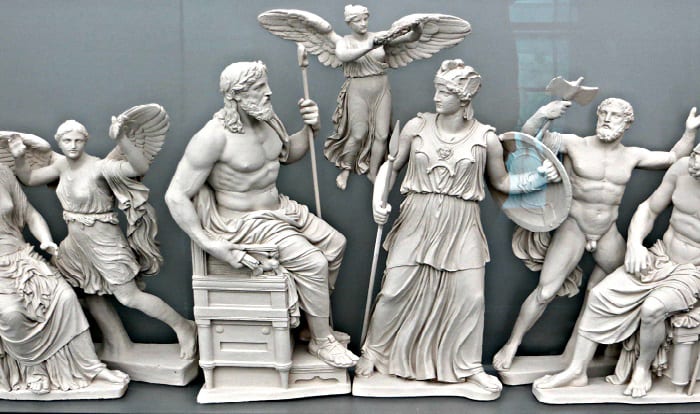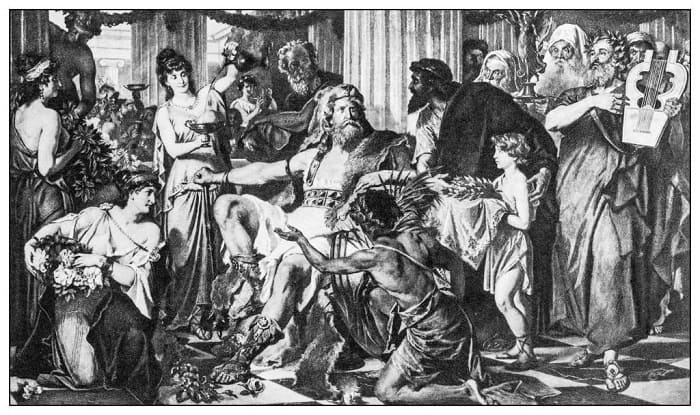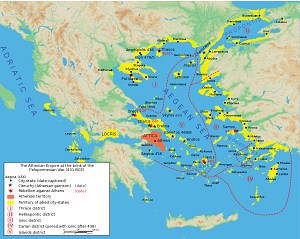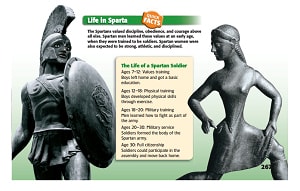If you are studying about Athens, you will surely cover topics regarding the Anthenian military. And in doing so, you will likely come across the question, “Which statement best describes Athens’s military?”
The textbook answer is that Athens had a strong and capable Navy. But it is important to know that the Athenian military had both an Army and a Navy. Keep reading to learn the essential details of both!
Table of Contents
Background Context
The Athens
Athens was a city in Ancient Greece’s classical period. It was a center for the arts, learning and philosophy, and more remarkably, the home of prominent philosophers, writers, and politicians, such as Aristophanes. Socrates, Sophocles, Plato, Pericles, etc. Today, it is also cited as the birthplace of democracy. Here is a map of the Athenian Empire:
The Athenian Military
As mentioned briefly above, the Athenian military had an Army and a Navy. These were the basis of Athens’ military power.
The Athenian Army
The Athenian Army was made up of citizen-soldiers of Ancient Greek city states. These citizen-soldiers primarily carried spears and shields. To overcome their disadvantage in manpower, they used the phalanx formation in wars.
Note: The phalanx formation was used in the Battle of Marathon (490 BCE) and the Battle of Thermopylae (480 BCE). It was also used in 479 BCE during the Battle of Plataea.
Every hoplite had an attendant who was lightly armed. The attendant was either a poor citizen who could not afford a suit of armor or a trusted slave. They carried the hoplite’s baggage and shield until the battle. Attendants were typically armed with javelins, slings, bows, and spears.
Apart from relieving a hoplite’s load, attendants also served as skirmishers before the battle. They would be assigned to guard the camp when the actual fight ensued, as well. In addition, at the closing of a battle, they would cover the main body retreat or slaughter fleeing enemy forces.
Aside from the hoplites, Athens maintained the epilektoi (meaning, “chosen”), which is a small but elite professional unit. Those in the epilektoi were selected from the regular citizen infantry.
The Atens developed a large and powerful Navy during the Greco-Persian Wars, which defeated the Persian’s Navy at the Battle of Salamis.
According to some records, the Athenian Navy had up to 80,000 crews and 400 ships. The backbone of the Navy was a group of professional rowers. The rowers were from the lower classes of the Anthenian society, but they played a major role in giving the Anthenian fleets an edge over its rivals’ fleets.
The Athenian Navy’s primary warships were the Triremes. The fleet of over 200 helped Athens secure control of the Aegean Sea while also protecting the trade routes and grain shipments from the Black Sea, which fed the city’s population.
Thanks to the Triremes, Athens gained hegemony over other Greek city-states and built the Athenian Empire. Although much of its fleet was destroyed during the Peloponnesian War, Athens recovered its naval power after the Second Athenian League was constructed.
Two sacred Athenian Navy ships were the Paralus and the Salaminia.
The Paralus
This ship was named after Poseidon’s mythological son. It was used as a messenger trireme in the late 5th century BC.
The Salaminia
The Slaminia was also a messenger ship that was used by the Athenian Navy in the late 5th century BC. Plus, it was used for special occasions, such as taking envoys to the Delphi oracle and transporting high-ranking statesmen.
Sparta vs. Athens
Athens’ main rival in Greece was Sparta. So, in this section, we will compare them with one another.
Anthenian boys from well-off families worked towards improving their bodies and minds. They learned to fight at a young age as the Athenian education focused on preparation for the military, but the training was not as lengthy or rigourous as Spartan training.
Unlike boys and men in Sparta, those in Athens did not have to dedicate their entire lives to the Army. They just had to join the Army for two years between the ages of 18 and 20 years old. In times of war, only older men had to serve in the Army.
Athens placed the greatest emphasis on government, education, religion, and culture. Boys learned to write, read, count, sing, and play musical instruments. They studied Greek literature and history and those from rich families hired private tutors for their sons. Boys were taught a wide range of subjects and how to be good public speakers. As such, boys were all equipped to participate in the Anthenian assembly.
Sparta was dominated by the military. Spartans believed that military power was the solution to security and protection for their city. Thus, life in Sparta reflected this belief.
Boys from a young age were trained to be soldiers. Here is an example of the life a Spartan soldier:
Spartan men would stay in the Army until 60 years old.
The Spartan government was also different from the Athen’s government. A characteristic of the government that describes Athens was that all citizens could debate any issue while having a mixture of elements of democracy, oligarchy, and monarchy best describes the Spartan government.
In the Persian Wars, Sparta and Athens worked together to emerge victorious. The Spartas primarily fought battles on land while the Athenians fought at sea. Following the Persian Wars, the Athenian fleet continued to safeguard Greece from the Persian Navy, and thus, held great influence over much of Greece.
But Sparta was worried about Athen’s power. Eventually, Sparta declared war. Today, we refer to this war as the Peloponnesian War.
Conclusion
There are many other topics regarding the Spartan and Athens with specific questions like “Where the Spartan soldiers helped save retreating members of the Greek Army?” and “Which statement best describes the Battle of Thermopylae?” but these are for another day. Hopefully, this article has helped you understand, “Which statement best describes Athens’s military?” If you have any other thoughts or questions, leave us a comment down below!

I am Everett Bledsoe, taking on the responsibility of content producer for The Soldiers Project. My purpose in this project is to give honest reviews on the gear utilized and tested over time. Of course, you cannot go wrong when checking out our package of information and guide, too, as they come from reliable sources and years of experience.




